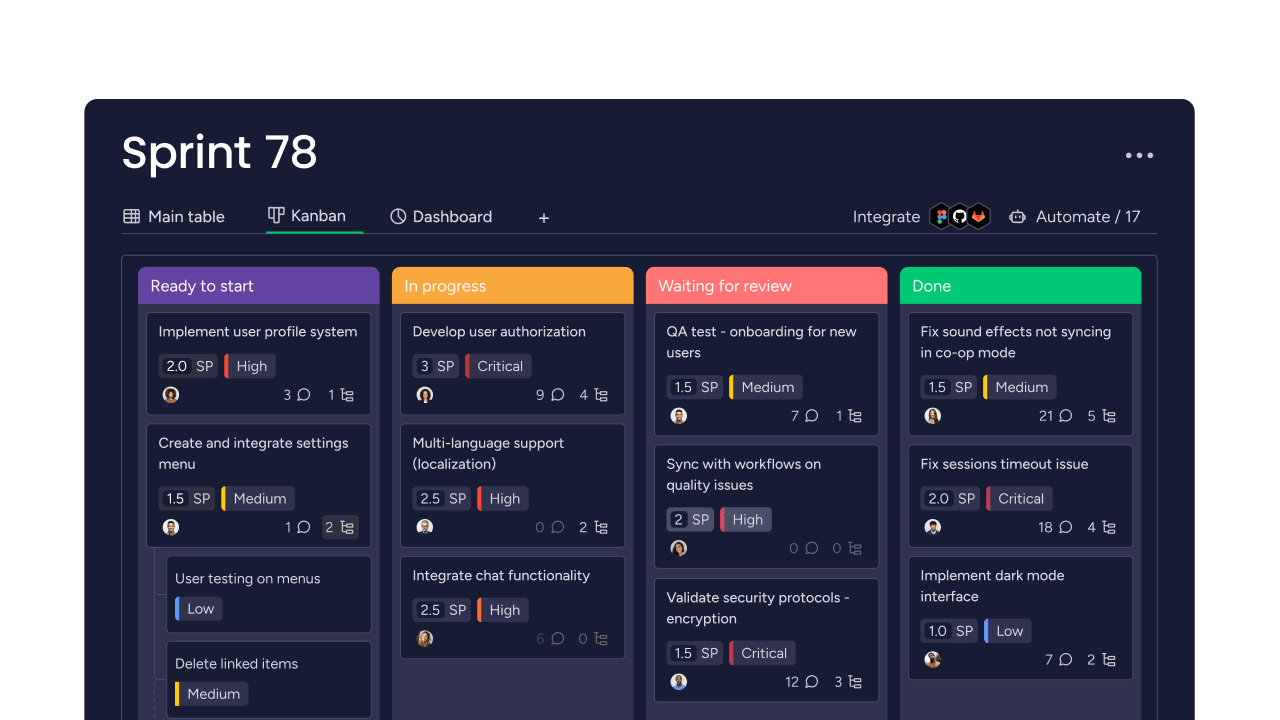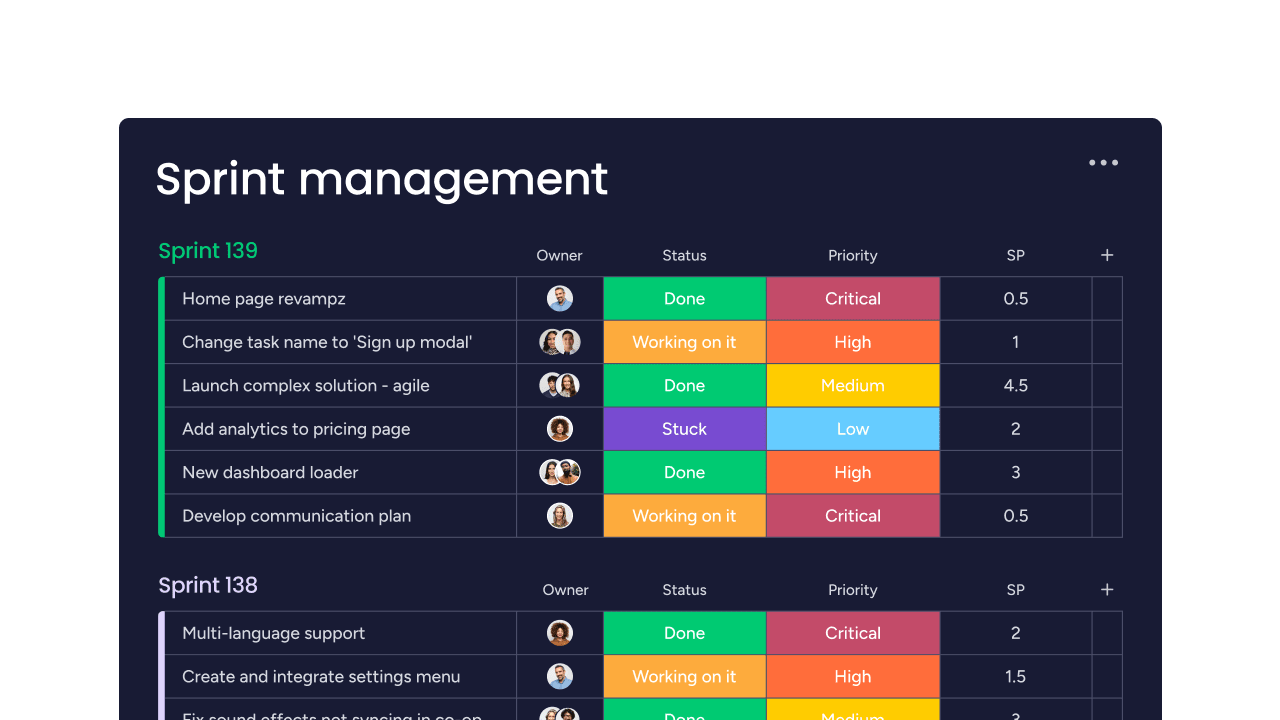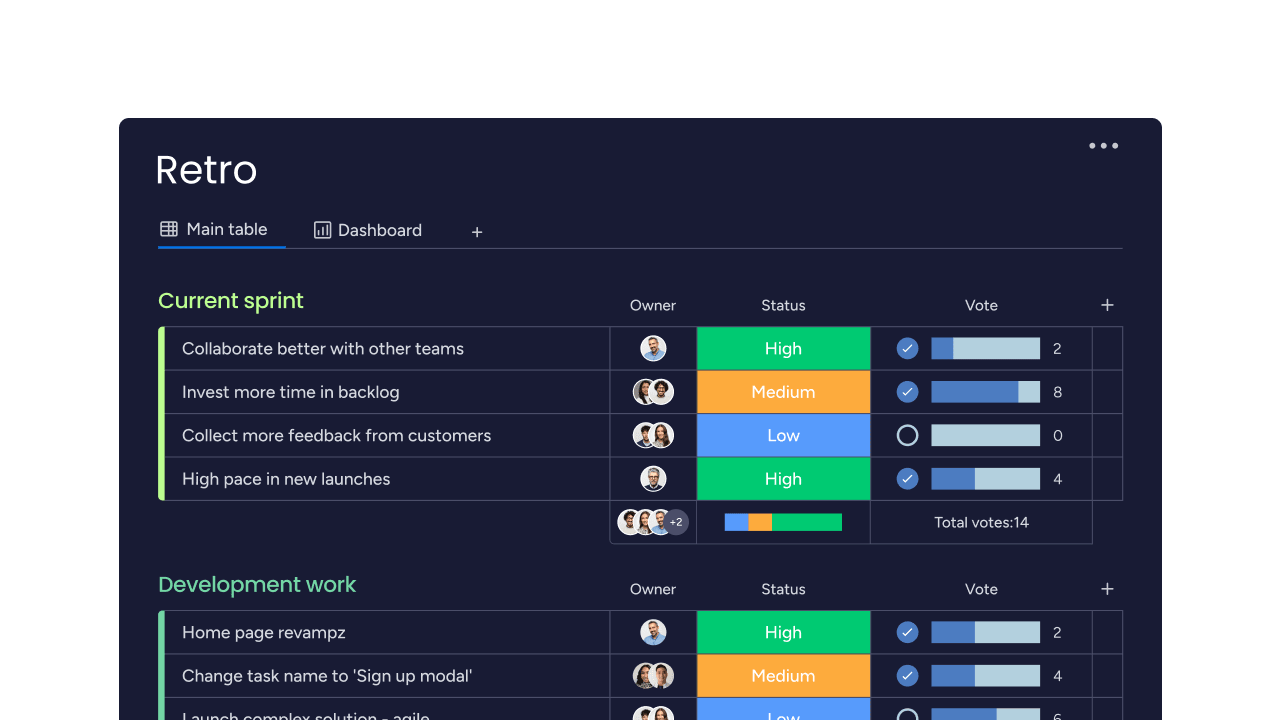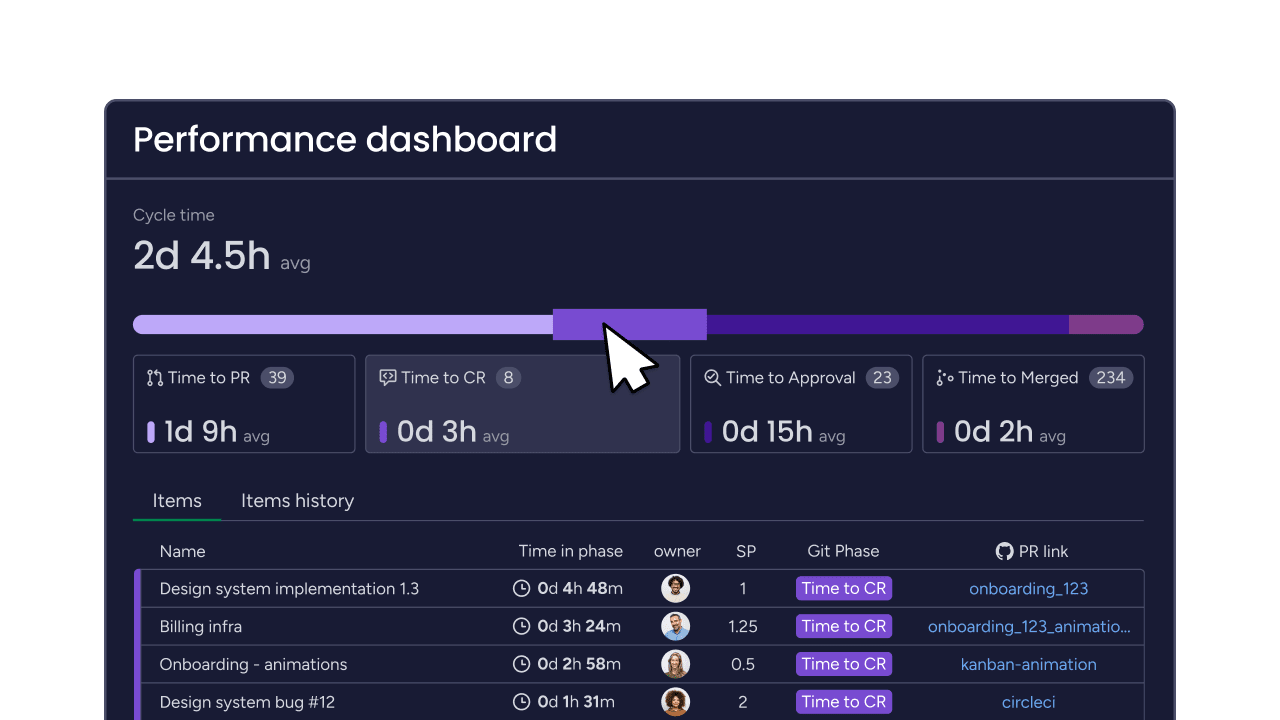Modern development teams face constant pressure to deliver faster, smarter, and with greater impact. But shifting priorities, communication silos, and rigid processes often slow progress and disconnect engineering from business goals. The result is lost momentum, unclear accountability, and missed opportunities to deliver meaningful value.
Agile best practices bridge that gap. They bring structure to flexibility — helping teams plan effectively, collaborate with purpose, and adapt quickly to change. When applied consistently, these practices create alignment from the product backlog to release, ensuring every sprint contributes to clear business outcomes.
The following strategies highlight what separates high-performing Agile teams from the rest. They’re designed to help teams remove friction, stay focused on priorities, and build a culture of continuous improvement that drives results across the organization.
Key takeaways
- Start small and scale deliberately: begin with three to five Agile practices that address your biggest delivery challenges, then expand gradually as the team adapts.
- Deliver working software frequently: release updates every two to four weeks through short sprints and dynamic backlogs to stay responsive to customer and market needs.
- Visualize progress to eliminate bottlenecks: use tools like Kanban boards and daily standups to improve visibility and limit work in progress for faster, more focused delivery.
- Empower teams with adaptable tools: leverage platforms such as monday dev for flexible sprint management, real-time visibility, and AI-powered insights that guide smarter decisions.
- Measure outcomes, not just output: track customer value, product impact, and team health to drive continuous improvement and sustained performance.
What are Agile best practices?
Agile best practices are proven methods and techniques that help development teams deliver value faster while adapting to change. Far from being outdated, a 2024 Forrester analysis shows that 95% of professionals affirm Agile’s critical relevance to their operations. These practices come from the Agile Manifesto’s Agile values — putting people and interactions first, focusing on working software, collaborating with customers, and responding to change.
Think of Agile best practices as the specific actions teams take to make these values real: they encompass techniques for Agile planning, running meetings, tracking progress, and improving continuously.

Why high-performing teams choose Agile methodology practices
High-performing teams adopt Agile practices because they solve real problems that slow down software delivery. Compared to Agile project management, traditional project management often creates long delays between planning and delivery, making it hard to respond when customer needs change.
Agile practices address these challenges directly:
- Faster delivery cycles: ship working software every two to four weeks instead of waiting months.
- Improved adaptability: pivot quickly when market conditions shift.
- Enhanced collaboration: cross-functional teams work together daily, not in silos.
- Higher customer satisfaction: regular feedback ensures you build what users actually need. In fact, according to McKinsey, companies with high developer velocity are 38% more likely to achieve higher customer satisfaction.
Modern platforms like monday dev support these practices with flexible Agile workflow setups that adapt to how your team works, making adoption smoother and more sustainable.
5 essential Agile planning best practices
Effective Agile planning gives teams structure without sacrificing flexibility. It ensures everyone understands priorities, aligns on goals, and can adapt quickly when conditions change. The most successful Agile teams treat planning as a continuous, collaborative process rather than a one-time event.
The following best practices outline how to balance strategy with adaptability: helping teams stay focused on delivering meaningful value while remaining responsive to feedback and evolving business needs.
1. Build adaptive product backlogs that drive value
A product backlog is your prioritized list of features and requirements, and ongoing backlog grooming ensures it stays current with feedback and business needs.
Start by writing user stories from the user’s perspective: “As a [user], I want [goal] so that [benefit].” Order these stories by business value and customer impact, not technical complexity.
Review and update your backlog weekly. Add clear acceptance criteria for each item so everyone knows what “done” means. This approach keeps your team focused on high-impact work instead of building features nobody uses.
2. Master sprint planning through collaborative sessions
Sprints are fixed time periods — usually 2-4 weeks — where teams commit to specific work. Sprint planning brings everyone together to decide what you’ll accomplish.
First, assess your team’s capacity based on past performance and current availability. Then select backlog items that fit within that capacity. Break these items into specific development activities.
End with a commitment ceremony where the team agrees to the sprint goal and scope. Good sprint planning prevents overcommitment and creates shared ownership across your team.
3. Create adaptive roadmaps for changing priorities
Agile roadmaps provide direction and clarity without the rigidity of fixed timelines. They outline strategic goals and evolving priorities, allowing teams to adapt quickly to new opportunities and shifting market demands.
To build an effective Agile roadmap:
- Organize by themes or epics: focus on outcomes and broader objectives rather than individual features.
- Plan in flexible time horizons: use quarterly goals for near-term focus and higher-level direction for later quarters.
- Review and adjust regularly: update plans monthly based on customer feedback, performance data, or strategic changes.
With platforms like monday dev, teams can visualize their Agile roadmap through customizable views that connect strategic priorities to real-time execution. This keeps every stakeholder aligned, informed, and confident in the team’s direction.
4. Implement user story mapping for customer-centric development
User story mapping is a key part of Agile product management and organizes features around user journeys, ensuring you build complete experiences, not disconnected features.
Map the main steps users take to reach their goals. Organize supporting features under each step. Identify the minimum viable features for each release.
Look for gaps in functionality that would improve the user experience. This approach keeps development focused on real user needs throughout the process.
5. Establish smart capacity planning for sustainable delivery
Capacity planning matches work commitments to what your team can actually deliver, so leveraging Agile estimation techniques can keep the pace sustainable over time.
Track velocity — how much work your team completes each sprint. Reserve 20% of capacity for unexpected work and learning. Balance work across team members’ skills to prevent bottlenecks.
It’s also really important to account for holidays, meetings, and other commitments. Proper capacity planning leads to predictable delivery and prevents team burnout.

5 critical Agile development practices for execution excellence
Effective execution turns Agile planning into measurable progress. These practices establish the daily structure, visibility, and collaboration needed to keep work flowing smoothly and teams aligned on shared goals.
When applied consistently, they help teams maintain momentum, reduce bottlenecks, and deliver high-quality software with fewer delays. From daily standups to automation, these techniques form the foundation of efficient, outcome-driven development.
1. Run high-impact daily standups
Daily stand-ups are one of several Agile ceremonies where team members share progress and surface blockers. Done well, they energize teams and catch problems early.
- What did you complete yesterday? Share actual progress made.
- What will you work on today? Coordinate efforts and spot conflicts.
- What’s blocking you? Get help before small issues become big problems.
It’s also important to note that standups should be focused on peer coordination, not status reporting to managers. When teams see immediate value from these meetings, attendance and engagement stay high.
2. Visualize your workflow with Kanban boards
Kanban boards show your workflow as columns representing different stages. Cards move across columns as work progresses, making bottlenecks visible instantly.
Set up columns like “To Do,” “In Progress,” “Review,” and “Done.” Add work-in-progress limits to prevent overload. Track how long items spend in each stage.
Digital boards in monday dev add extra power with automation, custom fields, and real-time updates that keep distributed teams synchronized.
3. Limit work in progress to maximize flow
Doing fewer things at once actually increases productivity. Work-in-progress (WIP) limits are integral to Kanban board templates by capping how many items can be in each workflow stage.
Benefits appear quickly when you implement WIP limits:
- Reduced context switching: deep focus on fewer items improves quality.
- Faster completion: items flow through your process more quickly.
- Fewer defects: less multitasking means fewer mistakes
- Visible bottlenecks: problems become obvious when work piles up
Always be sure to set limits based on your team size and work complexity too (you can always adjust as you come to learn what works best),
4. Build cross-functional collaboration into every sprint
Cross-functional teams bring together the Agile roles needed to deliver complete features — developers, designers, testers, and product experts working in sync throughout each sprint. Daily collaboration ensures faster decisions, fewer blockers, and a shared sense of accountability.
Encourage collaboration through:
- Shared workspaces: keep communication open and progress visible to everyone.
- Diverse perspectives: involve all roles in discussions and decisions to strengthen outcomes.
- Knowledge sharing: document insights so no single person becomes a bottleneck.
Fostering shared ownership helps close a significant perception gap between leadership and employees on accountability. When everyone contributes to sprint success, teams eliminate handoffs and miscommunication that slow delivery.
5. Automate routine tasks to amplify team focus
Automation removes repetitive, manual work so teams can focus on solving complex problems and delivering value. By streamlining key development and management processes, automation helps maintain momentum and reduces the friction that slows teams down.
Common automation opportunities include:
- Testing: catch bugs automatically to ensure consistent quality.
- Deployment: move code to production with a single click.
- Code quality: apply standards automatically before review.
- Progress updates: generate reports and notify stakeholders without disrupting developers.
With monday dev, automation extends beyond development workflows. Teams can trigger task updates, move items through stages, and sync progress across boards automatically: freeing more time to focus on building great software.
5 powerful Agile management practices for continuous growth
Agile management is about enabling teams rather than controlling them. The focus is on creating visibility, trust, and autonomy so teams can adapt quickly and deliver consistent results.
The following practices help teams stay aligned, measure progress effectively, and use data to drive improvement. Together, they support sustainable growth and high performance across every Agile organization.
1. Track velocity and burndown for predictable delivery
Velocity measures how much work your team completes each sprint. Agile velocity and burndown charts show remaining work over time. Together, they make delivery predictable.
Calculate velocity by averaging the last three to five sprints. Use burndown charts to compare actual progress against ideal progress. Look for patterns across multiple sprints.
These metrics help you make realistic commitments and spot problems early, whilst platforms like monday dev can automatically generate these charts from your sprint data.
2. Lead action-oriented sprint retrospectives
Agile retrospective sessions happen at sprint end, where teams reflect and identify improvements. Great retrospectives create real change, not just discussion.
Follow this structure for effective retrospectives:
- What went well: celebrate successes and practices to continue.
- What needs improvement: discuss challenges without blame.
- Action items: commit to specific changes for next sprint.
- Follow-up: check progress on previous commitments.
Create psychological safety so people share honest feedback. Focus on improving processes, not evaluating individuals.
3. Measure customer value delivery consistently
Success means delivering value to customers, not just completing features. Track outcomes that matter to users and the business.
Measure value through multiple lenses. Gather customer feedback regularly through surveys and usage data. Track which features users actually adopt. Connect development work to business metrics like revenue or retention.
These measurements guide better prioritization decisions and prove your team’s impact on business success, which is critical given that employees who understand how success is measured are 2x more likely to feel motivated.
4. Monitor team health through engagement metrics
Team health affects everything — productivity, quality, and retention. Healthy teams sustain high performance while unhealthy teams burn out.
Watch these health indicators:
- Satisfaction surveys: regular pulse checks on morale.
- Collaboration patterns: how well teams communicate and resolve conflicts.
- Growth opportunities: skills development and career progression
- Work-life balance: overtime patterns and stress levels.
Address health issues quickly before they impact delivery. Healthy, engaged teams build higher-quality products.
5. Apply data-driven insights for ongoing optimization
Use data to improve processes systematically. This scientific approach beats relying on opinions or assumptions.
Create dashboards that centralize key metrics. Analyze trends across different data points. Design experiments to test process changes. Make small, frequent adjustments based on evidence.
monday dev provides the analytics and reporting capabilities to support this data-driven improvement cycle.

How monday dev empowers your Agile team development practices
Bringing Agile principles to life requires the right balance of flexibility, visibility, and collaboration. monday dev delivers all three in one connected platform, turning best practices into daily habits that drive real results.
Built on the monday.com Work OS, it serves as a complete Agile solution
that supports any methodology, including Scrum, Kanban, and hybrid models. Teams can plan sprints, manage backlogs, and track progress in real time while maintaining the autonomy and transparency Agile development processes depend on.
The following capabilities show how monday dev helps teams plan, execute, and grow with confidence.
Flexible sprint management that adapts to your process
Every development team operates differently, and monday dev adapts to your unique approach — whether you follow Scrum, Kanban, or a custom Agile framework. The platform makes sprint management simple, structured, and fully customizable so your team can work their way without losing alignment.
Key capabilities include:
- Custom sprint boards: create boards with drag-and-drop fields for story points, priority levels, and acceptance criteria.
- Automated sprint ceremonies: use built-in templates to streamline planning sessions, reviews, and retrospectives.
- Dynamic backlog views: prioritize work with custom filters that surface high-impact items first.
- Native integrations: connect directly with GitHub, Jira, and GitLab to sync code changes automatically with sprint items.
Real-time visibility that empowers team autonomy
Transparency empowers teams when done right. monday dev provides visibility that helps rather than hinders.
Monitor sprint progress with real-time burndown charts that update as developers change item status. Set up automated Slack notifications that alert stakeholders when features move to testing without interrupting dev work. Use color-coded capacity indicators that instantly show when team members are overloaded. Leverage the Sprint Performance Dashboard to compare velocity across sprints and forecast completion dates based on your team’s actual working patterns.
Leaders get the information they need while teams maintain autonomy and focus.
Custom workflows for any Agile framework
Your Agile journey evolves over time. monday dev grows with you, supporting process changes without platform changes.
Jump-start implementation with pre-built templates for Scrum, Kanban, and SAFe frameworks. Customize your development pipeline with status columns that match your exact workflow stages—from “Design Review” to “Ready for QA.” Implement multi-step approval processes with automations that notify the right stakeholders at each gate. Create cross-team dependency views that connect your sprint work to other teams’ boards for seamless coordination across the organization.
AI-powered insights for smarter decision making
AI enhances human judgment by surfacing insights and automating routine decisions. monday dev’s AI capabilities make teams more effective without replacing human creativity.
- Use Risk Prediction to identify sprint items likely to slip based on historical patterns and complexity scores.
- Leverage Smart Tagging to automatically categorize backlog items by feature area, technical component, or business impact.
- Get Sprint Health recommendations that analyze your team’s workflow patterns and suggest process improvements like WIP limit adjustments.
- Apply AI-assisted task assignment that recommends the ideal team member for each item based on skills, workload, and past performance with similar work.
Start your high-performance Agile transformation now
Putting Agile best practices into action is how good teams become great ones. The strategies covered in this article are more than processes; they are the building blocks of an effective Agile transformation
that drives stronger collaboration, faster delivery, and continuous improvement.
Real transformation happens when teams start small, learn what works, and keep refining with every sprint. Over time, those improvements create lasting change, bringing more visibility, flexibility, and confidence to how teams deliver value.
A platform like monday dev helps make that transformation sustainable. By connecting planning, execution, and reporting in one place, it turns Agile principles into everyday workflows that help teams stay aligned and focused on outcomes.
Begin your Agile transformation today with monday dev and see how the right platform helps your team perform at its best.

Frequently asked questions
What is the difference between Agile and Scrum methodologies?
The difference between Agile and Scrum methodologies is that Agile is the overall philosophy and set of values, while Scrum is one specific framework for implementing those values. Scrum provides structured roles like Product Owner and Scrum Master, ceremonies like sprint planning, and artifacts like the product backlog that help teams apply Agile values daily.
How long does it take to see results from implementing Agile practices?
When implementing Agile practices, most teams see initial results like improved collaboration and delivery speed within two to three sprints, which is typically 4-6 weeks. Full transformation including cultural change usually takes six months to a year, depending on organization size and commitment level.
Can Agile methodology work for non-software development teams?
Yes, Agile works for any team dealing with changing requirements who needs iterative delivery. Marketing teams use it for campaigns, HR teams for recruitment, and operations teams for process improvement across various industries.
What are the most common mistakes when implementing Agile practices?
The biggest mistakes include trying to change everything at once, lacking management support, and focusing on ceremonies over principles. Teams succeed by starting small, getting leadership buy-in, and emphasizing collaboration over rigid process adherence.
How do you measure the success of Agile practices?
Measure success through faster time-to-market, improved customer satisfaction scores, team productivity metrics, and reduced project failure rates. Track both delivery metrics like velocity and outcome metrics like feature adoption and customer retention.
Which Agile framework works best for distributed remote teams?
Kanban often suits distributed teams well because it emphasizes visual workflow management over synchronized ceremonies. However, remote teams successfully use Scrum with digital collaboration platforms like monday dev and adjusted meeting schedules for different time zones.
 Get started
Get started 


